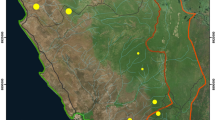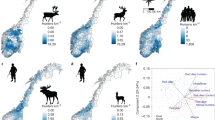Abstract
Because rapidly expanding human populations have devastated gorilla (Gorilla gorilla) and common chimpanzee (Pan troglodytes) habitats in East and West Africa, the relatively intact forests of western equatorial Africa have been viewed as the last stronghold of African apes1. Gabon and the Republic of Congo alone are thought to hold roughly 80% of the world's gorillas2 and most of the common chimpanzees1. Here we present survey results conservatively indicating that ape populations in Gabon declined by more than half between 1983 and 2000. The primary cause of the decline in ape numbers during this period was commercial hunting, facilitated by the rapid expansion of mechanized logging. Furthermore, Ebola haemorrhagic fever is currently spreading through ape populations in Gabon and Congo and now rivals hunting as a threat to apes. Gorillas and common chimpanzees should be elevated immediately to ‘critically endangered’ status. Without aggressive investments in law enforcement, protected area management and Ebola prevention, the next decade will see our closest relatives pushed to the brink of extinction.
This is a preview of subscription content, access via your institution
Access options
Subscribe to this journal
Receive 51 print issues and online access
$199.00 per year
only $3.90 per issue
Buy this article
- Purchase on Springer Link
- Instant access to full article PDF
Prices may be subject to local taxes which are calculated during checkout




Similar content being viewed by others
References
Oates, J. F. African Primates: Status Survey & Action Plan (IUCN, Cambridge, 1996)
Harcourt, A. H. Is the gorilla a threatened species? How should we judge? Biol. Conserv. 75, 165–176 (1996)
Minnemeyer, S., Walker, T., Collomb, J. G., Cotton, L. & Bryant, D. An Analysis of Access to Central Africa's Rainforests (World Resources Institute, Washington, 2002)
Roberts, L. (ed.) World Resources 292 (Oxford Univ. Press, New York, 1998)
Tutin, C. E. G. & Fernandez, M. Nationwide census of gorilla (Gorilla g. gorilla) and chimpanzee (Pan t. troglodytes) populations in Gabon. Am. J. Primatol. 6, 313–336 (1984)
Georges, A. J. et al. Ebola hemorrhagic fever outbreaks in Gabon, 1994–1997: Epidemiologic and health control issues. J. Infect. Dis. 179, S65–S75 (1999)
Chamberlin, C. Migration of Fang into central Gabon during the 19th century—a new interpretation. Int. J. Afr. Hist. Stud. 11, 429–456 (1978)
Pourtier, R. Le Gabon Vol. 1 (Harmattan, Paris, 1989)
Wilkie, D. S., Shaw, E., Rotberg, F., Morelli, G. & Auzel, P. Roads, development, and conservation in the Congo Basin. Conserv. Biol. 14, 1614–1622 (2000)
Rapport des activites de la Lutte Antibracionnage, Brigade de Faune de la Lope (Direction de la Faune et de le Chasse, Libreville, Gabon, 1999).
Angoué, C. et al. in L'avenir des peuples des forêts tropicales—Rapport final Vol. III (eds Bahuchet, S. & de Maret, P.) (Université Libre de Bruxelles, Brussels, 2000)
Huijbregts, B., de Wachter, P. & Ndong Obiang, L. S. Ebola and the decline of gorilla (Gorilla gorilla) and chimpanzee (Pan troglodytes) populations in the Minkebe Forest, north-eastern Gabon. Oryx (in the press)
Lahm, S. A. Ecology and Economics of Human/Wildlife Interaction in Northeastern Gabon. Dissertation, New York Univ. (1993)
Brugière, D. & Sakom, D. Population density and nesting behaviour of lowland gorillas (Gorilla gorilla gorilla) in the Ngotto forest, Central African Republic. J. Zool. 255, 251–259 (2001)
Barnes, R. F. W., Barnes, K. L., Alers, M. P. T. & Blom, A. Man determines the distribution of elephants in the rain forests of northeastern Gabon. Afr. J. Ecol. 29, 54–63 (1991)
Bermejo, M. Status and conservation of primates in Odzala National Park, Republic of the Congo. Oryx 33, 323–331 (1999)
Blom, A. The monetary impact of tourism on protected area management and the local economy in Dzanga-Sangha (Central African Republic). J. Sust. Tourism 8, 175–189 (2001)
Wilkie, D. S. & Carpenter, J. Can nature tourism help finance protected areas in the Congo Basin? Oryx 33, 333–339 (1999)
Buckland, S. T., Anderson, D. R., Burnham, K. P. & Laake, J. L. Distance Sampling: Estimating Abundance of Biological Populations (Chapman & Hall, London, 1993)
Walsh, P. D. & White, L. J. T. What it will take to monitor forest elephant populations. Conserv. Biol. 13, 1194–1202 (1999)
Hedley, S. L., Buckland, S. T. & Borchers, D. L. Spatial modelling from line transect data. J. Cetacean Res. Manage. 1, 255–264 (1999)
Kingdon, J. The Kingdon Field Guide to African Mammals (Academic, San Diego, 1997)
Acknowledgements
This paper is dedicated to Annelisa Kilbourn who died on 2 November 2002 in a plane crash en route to her Ebola research site. For support of ape survey work we thank USAID-CARPE, the DGIS, the MacArthur Foundation, WCS, WWF and the Republique Gabonaise. Funding for the socioeconomic surveys was provided by NSF. D. Purves, S. Sandin and J. Regetz provided helpful comments on statistical analyses.
Author information
Authors and Affiliations
Corresponding author
Ethics declarations
Competing interests
The authors declare that they have no competing financial interests.
Supplementary information
Rights and permissions
About this article
Cite this article
Walsh, P., Abernethy, K., Bermejo, M. et al. Catastrophic ape decline in western equatorial Africa. Nature 422, 611–614 (2003). https://doi.org/10.1038/nature01566
Received:
Accepted:
Published:
Issue Date:
DOI: https://doi.org/10.1038/nature01566
This article is cited by
-
Projecting the impact of an ebola virus outbreak on endangered mountain gorillas
Scientific Reports (2023)
-
The Risks of Yellow Fever to Asian Primates
International Journal of Primatology (2022)
-
The genetic impact of an Ebola outbreak on a wild gorilla population
BMC Genomics (2021)
-
Rapid transmission of respiratory infections within but not between mountain gorilla groups
Scientific Reports (2021)
-
Trojan hosts: the menace of invasive vertebrates as vectors of pathogens in the Southern Cone of South America
Biological Invasions (2021)
Comments
By submitting a comment you agree to abide by our Terms and Community Guidelines. If you find something abusive or that does not comply with our terms or guidelines please flag it as inappropriate.



